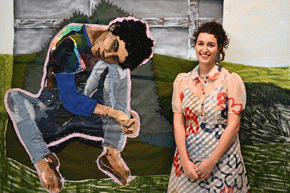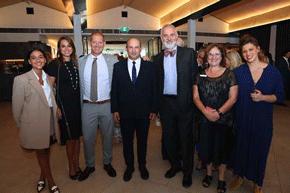Second synagogue from Second Temple Period found in Migdal in North
A 2000-year-old synagogue from the Second Temple period was recently discovered in Migdal, a large Jewish settlement from this period, the first time that two synagogues from the Second Temple period have been found in the same locale.

The excavation. (University of Haifa)
Migdal served as the main base for Yosef Ben Matityahu (Flavius Josephus) in his war against the Romans in Galilee during the Great Revolt.
“The discovery of a second synagogue in this Galilean settlement casts light on the social and religious lives of the Jews in the area in this period, and reflects a need for a dedicated building for Torah reading and study and for social gatherings,” commented Dina Avshalom-Gorni, one of the directors of the excavations.
“We can imagine Mary Magdalene and her family coming to the synagogue here, along with other residents of Migdal, to participate in religious and communal events. The exposure of a second synagogue casts new light on Jewish communal life in the Galilee, the area where, according to the New Testament, Jesus performed his miracles,” she added.
The archeological excavations at the site are being conducted by Y.G. Contractual Archeology Ltd., headed by Yehuda Govrin, and under the academic auspices of the Zinman Institute of Archaeology at the University of Haifa.
As in many other instances across Israel, the important discovery was chanced upon as pst of a construction project, in this case, a salvage excavation as part of the expansion of Route 90 and the Migdal intersection.
Situated on the northwest shore of the Sea of Galilee, Migdal was a large Jewish settlement 2,000 years ago. Following the destruction of the Second Temple, it served Flavius Josephus as his main base in his war against the Romans in the Galilee.
Migdal is also mentioned in Christian texts as the birthplace of Mary Magdalene, a prominent supporter of Jesus who is known as “the apostle to the apostles.”
The eastern side of Migdal was excavated over a decade ago by the Israel Antiquities Authority (IAA). A synagogue discovered at the time was also dated to the Second Temple period.
A unique stone was uncovered in the centre of the synagogue bearing a relief of a seven-branched Menorah. The researchers suggest that the artist who created the relief was replicating the Menorah positioned in the Temple.
The newly-excavated synagogue is described as “a broad, square-shaped building” constructed from basalt and limestone. It comprises a central hall and two additional rooms. The walls of the central hall are coated with white and coloured plaster. A stone bench, also coated in plaster, runs along the walls. In a small room on the south side of the hall, a plaster-coated stone shelf was found. The room may have been used to store scrolls.
The building uncovered in the 2009 excavations was the first synagogue from the Second Temple period found in the Galilee, and the ninth in the entire country. Now, a second synagogue has been found in the same settlement.
Prof. Adi Erlich, head of the Zinman Institute of archaeology at the University of Haifa. Said that “the fact that we have found two synagogues shows that the Jews of the Second Temple period were looking for a place for religious, and perhaps also social, gatherings. The stone bearing a relief of the Menorah from the other synagogue at Migdal, suggests that the local Jews saw Jerusalem as their religious centre, and their local activities took place under this centrality.”
“The synagogue we are excavating now is close to the residential street, whereas the one excavated in 2009 was surrounded by an industrial area. Thus the local synagogues were constructed within the social fabric of the settlement,” he explained.









